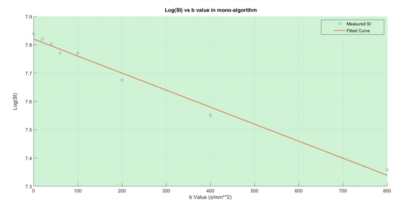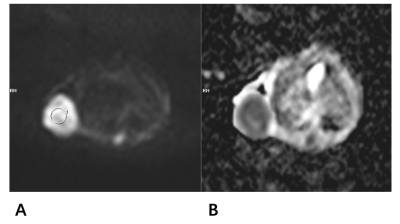4732
The feasibility of ADC in optimizing chemotherapy for 5-FU-resistant gastric cancer with mouse model: when should replace 5-FU with paclitaxel?
Jia Sun1, Lai-yun Zhang1, Lei Yang1, Zhu-lin Li1, Qing-lei Shi2, and Tao Jiang1
1Beijing Chaoyang Hospital of Capital Medical Universit, Beijing, China, 2Siemens Healthcare,MR Scientific Marketing,Beijing China, Beijing, China
1Beijing Chaoyang Hospital of Capital Medical Universit, Beijing, China, 2Siemens Healthcare,MR Scientific Marketing,Beijing China, Beijing, China
Synopsis
In this study, we verified the feasibility of apparent diffusion coefficient (ADC) values in predicting chemotherapy response and optimizing chemotherapy regimen for gastric cancer that is resistant 5-FU with mouse model. We found that based on the early changes of ADC to replace 5-FU with paclitaxel in advance can effectively reduce tumor burden which means it may be possible to use ADC values as a reliable bio-marker in predicting chemotherapy response and optimizing chemotherapy regimen for gastric cancer.
PURPOSE
To verify the feasibility of ADC values in predicting chemotherapy response and optimizing chemotherapy regimen for gastric cancer that is resistant 5-FU with mouse model, which is to find the optimum time to replace 5-FU with paclitaxel.MATERIALS AND METHODS
The animal study was approved by the Institutional Animal Care and Use Committee of Capital medical university. Ten patient-derived xenografts (PDX) mouse models were established using 5-FU-resistant gastric cancer cells coming from patients, and were randomly divided into two groups. The basic information, like weight and gender, were analyzed and no significant difference was found. All mouse were fed at the same temperature, humidity and diet conditions. All established mouse models were underwent DWI exam using a prototype integrated slice-specific shimming (iShim) sequence with b values (0, 1000 s/mm2) on a MAGNETOM Prisma 3T MR scanner (Siemens Healthcare, Erlangen, Germany) with a phase-array 16 channels wrist coil before and after treatment with 5-Fu as first-line chemotherapy and Paclitaxel as second chemotherapy. Values of ADCs and volumes of tumors were measured using an open-source software named ITK-SNAP (https://itk.org/). The time points that replace 5-FU with paclitaxel was determined according to the change direction of ADCs (from increase to decrease) in experimental group and change ratio of volume ((Vafter-Vbefor)/ Vbefor) in control group. Independent-sample t test was applied to analyze ADC changes of the tumors during the growth period and to compare the tumor burden at the end of the observation between the two groups.RESULTS
ADC values increased gradually after 6 days of 5-FU treatment, but start decrease 10 days compared with the latest time treatment at 10 days after therapy, after which the chemotherapy was replaced with paclitaxel in experimental group. The change ratio of volume significantly increased at 10 days after 5-Fu treatment (from 35% to 45%), after which the chemotherapy was replaced with paclitaxel. At the end of 16 days after treatment for both groups, the tumor burden in experimental group was significantly less than that in control group (1.619mm3vs 1.71mm3, P<0.05).DISCUSION
For the majority of non-surgical gastric cancer patients, early evaluation of the therapy response is an effective measure to improve the prognosis. Many studies have shown that ADC value can evaluate the treatment effect earlier than morphological changes[1-2]. However, due to the differences among patients and the heterogeneity among tumors, it is difficult to get a quantitative value with high consistency and repeatability. In this study, animal experiments were used to compare the tumor burden at the end of the chemotherapy based on the changes of ADCs and volumes of the tumor. In DW imaging, we used a the prototype sequence named integrated shimming (iShim) DWI, which acquires a 2D-field map for each EPI imaging slice that is used to determine the optimal center frequency and gradient offsets for the imaging slice. Center frequency and gradient offsets are then updated before the acquisition of each imaging slice in real time. This sequence is effective in reducing the susceptibility artifacts at 3T for diffusion weighted imaging (DWI) in small and complex anatomy [3].CONCLUSION
Basing on the early changes of ADC after chemotherapy, to replace 5-FU with paclitaxel in advance can effectively reduce tumor burden in 5-FU-resistant gastric cancer with mouse model. In future, it may be possible to use ADC values as a reliable bio-marker in predicting chemotherapy response and optimizing chemotherapy regimen for gastric cancer.Acknowledgements
No acknowledgement found.References
1. Cui Y, et al. Radiology 2008 Sep;248(3): 894-900.
2.Sun YS, et al. Radiology 2010Jan;254(1):170-178.
3. Zhang, H., et al. Invest Radiol 2016 51(5): 297-305.
Figures

Figure 1 The measured signal intensity at different b values and the fitted curve with a mono-exponentional algorithm.

Figure 2 The variation of ADCs at different days before (A) and after (B)chemotherapy. The ADC values were decreased in initial days and increased from 6thday afterchemotherapy, with a highest value on eight day which is also the time points that replace 5-FU with paclitaxel in experimental group (B).

Figure 3 The variation of volumes at different days before (A) and after (B)chemotherapy. The change ratio of volume ((Vafter-Vbefor)/ Vbefor) was significant increased on 10thday which is also the time points that replace 5-FU with paclitaxel in control group (B).

Figure 4 The high b (1000 s/mm2) value DW image (A) and ADC map image(B). The ROI was drawn at the slice with a maximum diameter.